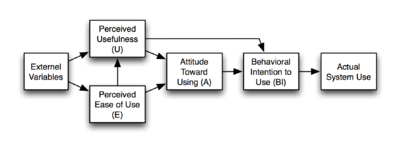- Technology Acceptance Model
-
Das Technology Acceptance Model ist ein informationstheoretisches Modell, welches Aussagen darüber trifft, warum Personen eine Technologie nutzen oder nicht nutzen. Es wurde in der Dissertation von Davis[1]entwickelt und 1989[2] veröffentlicht.
Inhaltsverzeichnis
Geschichte
Vorherige Studien waren zu der Empfehlung gekommen, für die Untersuchung von Technologienutzung bei Informationssystemen auf Modelle aus der empirischen Sozialforschung zurückzugreifen[3]. Grundlage des TAMs bildet daher auch das sozialpsychologische Modell Theory of Reasoned Action (TRA) von Ajzen und Fishbein von 1980[4]. Im Jahr 2000 wurde das ursprüngliche Modell von Venkatesh und Davis um einige Elemente erweitert und als TAM2 neu veröffentlicht [5]. Eine weitere Überarbeitung erfolgte 2003 von Venkatesh, Morris und Davis als Unified Theory of Acceptance and Use of Technology (UTAUT)[6] und 2008 von Venkatesh und Bala als TAM3[7].
Aufbau
TAM postuliert, dass die Attitude Toward Using (A) zur Nutzung einer Technologie durch eine Person entscheidend von zwei Variablen abhängig ist, der wahrgenommene Nützlichkeit (Perceived Usefulness) und der wahrgenommene Benutzerfreundlichkeit (Perceived Ease of Use). Die Perceived Usefulness (U) ist die subjektive Empfindung der Person, dass die Anwendung einer bestimmten Technologie seine Arbeitsleistung verbessert. Die Perceived Ease of Use E wiederum misst die Wahrnehmung der Person, mit wie viel – oder besser mit wie wenig – Aufwand das Erlernen der Nutzung der neuen Technologie verbunden ist. Ferner ist die Intention zur Nutzung (Intention to Use, BI) abhängig von der Perceived Usefulness und der Attitude ist.
Verbreitung
Das Technology Acceptance Model ist zu einem weit verbreiteten Instrument zur Untersuchung von Technologienutzung im IS-Bereich geworden [8]. Gründe dafür mögen in seiner Verständlichkeit und Simplizität liegen, aber auch in der hohen Reliabilität seiner Eingangsvariablen, welche in einer Metaanalyse von King (2006) belegt werden konnte. Das Modell wurde dabei häufig für den jeweiligen Kontext modifiziert. Bisherige Untersuchungen mit dem TAM deckten ein breites Spektrum verschiedener Bereiche ab. So variierte der Teilnehmerkreis mit Laien, Studenten und Experten, ebenso der Anwendungsbereich mit Computertechnologie und anderer Technologie sowie der Kulturkreis mit westlichen und nicht westlichen Ländern[9]. Es wurde eine substanzielle Zunahme der jährlichen, auf TAM basierenden Untersuchungen festgestellt. Laut der Analyse von King (2006) stieg die Anzahl der pro Jahr veröffentlichten Studien von vier in den Jahren 1998 - 2001 auf zehn in den Jahren 2002 - 2003. Aktuell (März 2011) sind laut des Onlineverzeichnisses GVK-Plus des Gemeinsamen Bibliotheksverbunds in den ersten beiden Monaten des Jahres 2011 bereits sechs Studien zum Stichwort „Technology Acceptance Model“ veröffentlicht worden.
Erweiterungen
Im Jahr 2000 wurde das TAM von Vvenkatesh und Davis um einige Eingangsvariablen erweitert und ausdifferenziert, welche in die Gruppen sozialer Einfluss und kognitive Prozesse (Social Influence, Cognitive Instrumental Process) eingeteilt wurden. Im Rahmen dieser neuen Studie wurde die Validität dieser Eingangsvariablen in vier Längsschnittstudien nachgewiesen.
Zur Gruppe des sozialen Einflusses gehören die Variablen Subjective Norm, Image und Freiwilligkeit ('Voluntariness). Ferner wird eine Variable Erfahrung (Experience) definiert, die Einfluss auf erstgenannte Variablen hat.
Subjective Norm wurde direkt aus dem TRA-Modell entnommen [10]. Sie wurde im ursprünglichen TAM noch aus Gründen der ungenügenden Erforschung ausgeklammert, hier aber wieder eingeführt. Es wird impliziert, dass Subjective Norm einen direkten positiven Effekt auf die Intention to Use hat, wenn die Technologienutzung vorgeschrieben ist. Zudem hat diese einen positiven Effekt auf Image. Image wird definiert als „Grad des Einflusses der Nutzung einer Technologie auf den Status der Person“. TAM2 postuliert einen positiven Effekt von Subjective Norm auf Image und einen positiven Effekt von Image auf Perceived Usefulness. Ferner wird die Variable Experience eingeführt. Höhere Experience hat einen abmildernden Wirkung des direkten Effekts von Subjective Norm auf Intention to Use bei unfreiwilliger Nutzung und ebenso eine mildernde Wirkung des positiven direkten Effektes von Subjective Norm auf die Perceived Usefulness.
Zur zweiten Gruppe, den kognitiven Prozessen, gehören die Variablen Jobrelevanz (Job Relevance), Outputqualität (Output Quality) und Ergebnisklarheit (Result Demonstrability).
Job Relevance wird definiert als Wahrnehmung einer Person über die Eignung der Nutzung einer Technologie für seine Arbeit, also ob die Funktionen eines Systems ihm bei der Erfüllung seiner Aufgaben helfen. Job Relevance habe einen positiven Effekt auf Perceived Usefulness. Während Job Relevance ein eher quantitatives Maß dafür darstellt, inwiefern eine Technologie bei der Arbeit hilft, ist die Output Quality ein qualitatives Maß der Wirksamkeit. Output Quality hat einen positiven Effekt auf die Perceived Usefulness. Result Demonstrability schließlich sagt etwas darüber aus, ob und inwieweit eine Steigerung der Arbeitsleistung direkt der neuen Technologie zugeschrieben werden kann. Verbessert ein System die Leistung auf eine nicht merkliche Weise, nimmt der Nutzer die Vorteile des Systems schlechter war. Result Demonstrability hat ebenfalls einen positiven Effekt auf die Perceived Usefulness.
Einzelnachweise
- ↑ Davis, F. (1985), A technology acceptance model for empirically testing new end-user information systems - theory and results, PhD thesis, Massachusetts Inst. of Technology.
- ↑ Davis, F., Bagozzi, P. and Warshaw, P. (1989), ‘User acceptance of computer technology - a comparison of two theoretical models’, Management Science 35(8), 982–1003.
- ↑ Christie, B. (1981), Face to File Communication - A Psychological Approach to Information Systems, Wiley.
- ↑ Ajzen, I. and Fishbein, M. (1980), Understanding Attitudes and Predicting Social Behavior, Prentice Hall.
- ↑ Venkatesh, V. and Davis, F. (2000), ‘A theoretical extension of the technology acceptance model: Four longitudinal field studies.’, Management science 46(2), 186–204.
- ↑ Vvenkatesh, V., Morris, M., Davis, F. and Davis, M. (2003), ‘User acceptance of information technology - toward a unified view’, MIS Quaterly 27(3), 425–478.
- ↑ Venkatesh, V. and Bala, H. (2008), ‘Technology acceptance model 3 and a research agenda on interventions’, Decision Science 39(2), 273–315.
- ↑ King, W. R. (2006), ‘A meta-analysis of the technology acceptance model’, Information & Management 43(6), 740–755.
- ↑ Schepers, J. (2007), ‘A meta-analysis of the technology acceptance model - investigating subjective norm and moderation effects’, Information & Management 44(1), 90–103.
- ↑ Fishbein, M. and Ajzen, I. (1975), Belief, Attitude, Intention and Behavior - An Introduction to Theory and Research, Addison-Wesley.
Wikimedia Foundation.


